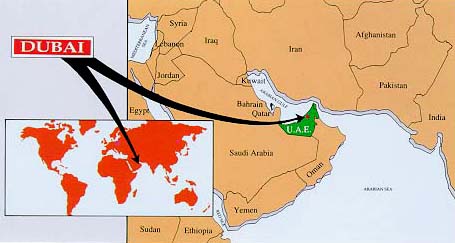|
About 80% of the UAE's area is in Abu Dhabi. The climate is hot and dry, with mean January temperatures of 18 deg C (65 deg F) and mean July temperatures of 33 deg C (92 deg F). Rainfall averages 152 mm (6 in) annually. The major natural resource is petroleum.
HISTORY AND GOVERNMENT
At one time this area was known as the "Pirate Coast," reflecting the major occupation of the inhabitants. To protect its ships, Great Britain, beginning in 1820, made several treaties with the Arab leaders outlawing sea battles. Britain handled foreign relations for the area, then known as Trucial Oman or the Trucial States. The United Arab Emirates gained full independence on 2nd of December 1971, although Ras al-Khaimah did not join until 1972. There are no elections or legal political parties; authority rests with the seven hereditary sheikhs, who control their own domains and choose a president from among their number. Zayed bin Sultan Al-Nahayyan, of Abu Dhabi, has been president since 1971. After the Iraqi invasion of Kuwait on Aug. 2, 1990, the government allowed the deployment of U.S. warplanes on its territory. Military units from the UAE participated as part of the U.S.-led coalition in the liberation of Kuwait early in 1991

The United Arab Emirates
The United Arab Emirates (UAE); composed of the sheikhdoms of Abu Dhabi, Dubai, Sharjah, Ras Al-Khaimah, Umm Al-Quwain, Ajman, and Fujairah. The UAE is located on a flat coastal plain of the Arabian Peninsula, along the Persian Gulf. The borders with Qatar on the northwest, Saudi Arabia on the south and west, and Oman on the east are undefined, as are the borders between the individual sheikhdoms. Two neutral zones are shared by several sheikhdoms.
My Corkboard
|